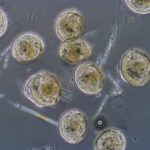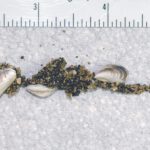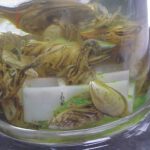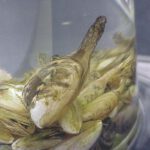T
he quagga mussel is an invasive species that, over the last 30 years, has heavily colonized the Great Lakes. Its hydrodynamic, geochemical, optical, and ecological effects are so great that the species is termed an “ecosystem-revising organism” or “ecosystem engineer.” Now, quaggas are spreading to the rivers of California, Lake Mead, and other water bodies in the West—largely thanks to human enablers. Not only does the quagga affect water bodies from an ecological point of view, it can also pose major problems for irrigators and water suppliers.
Russell Cuhel and Carmen Aguilar are scientists at the University of Wisconsin–Milwaukee’s School of Freshwater Sciences who have researched the quagga mussel from a biological and ecological point of view. They have also provided advice to water users in the West about how best to deal with the coming quagga invasion. In this interview with Municipal Water Leader Managing Editor Joshua Dill, Dr. Cuhel and Dr. Aguilar discuss the experience of the Great Lakes, particularly Lake Michigan, their area of firsthand expertise, and the lessons it can provide to the western states.
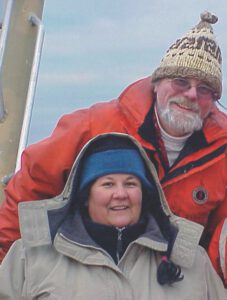 Joshua Dill: How and when did the quagga mussel invade the Great Lakes, and what have the effects been?
Joshua Dill: How and when did the quagga mussel invade the Great Lakes, and what have the effects been?
Russell Cuhel: Both the quagga and the zebra mussel came from the Dnieper River in Ukraine. They were transported in the ballast water of transatlantic shipping that came up into the Great Lakes via the St. Lawrence Seaway, through the canals and locks, and ultimately into Lake Superior. It is likely that they were first discharged into the Great Lakes in 1988 or 1989. They made an appearance in Lake Erie shortly thereafter. Here in Lake Michigan, they did not appear until the early 2000s—2002 or 2003. They undoubtedly were in all the Great Lakes by 1990, but because each of the lakes is different in its structure and the way that water and people move around, they did not become established in each lake at the same time. Some areas, like Green Bay, had a much more rapid initial establishment of zebra and quagga mussels than did the main basin of Lake Michigan, but neither reached the fantastic population densities found in less sediment-laden water.
We got a phone call in 2007 from the Metropolitan Water District in Los Angeles saying that they had quagga mussels in Lake Mead and Lake Havasu and asking for our advice. As far as we know, zebra mussels have not established themselves in California; quagga mussels were the first ones to get there.
When people remove the visible mussels from the bottom of their boats, that is superficial at best. The real problem is the almost-invisible mussel larvae, known as veligers, that get into the cooling systems of boat engines.
They are inconspicuous, and as a result, they are being transported all over. In Lake Michigan, for the first 10 years, the veligers were seasonal; you only saw them in the water from late August to early October. They live in the water for about 6 weeks before they settle out. The adults were spawning in July and August and the mollusk larvae were swimming around in the water in September. That is when Labor Day falls, and in high-and mid-latitude areas, that is typically when people take their boats out of the water. The engine-cooling water in September is full of veligers—they live in the upper water, not on the bottom. Then people trailer their boats out to the West Coast. The trip only takes a couple of days, and it is not very hot out, so the water in the engines and cooling systems of the boats stays normal in temperature and the veligers survive. When the boat gets started in the new water area the veligers are released.
Carmen Aguilar: One of the things to make sure that people understand is that quagga mussel veligers are present in the surface water. Quagga mussels reproduce by broadcast spawning, like corals do. They throw gametes into the water, which encounter each other and stay in the surface water. That is how they get into the engines. You can see and remove adult mussels, but you will not be able to see the veligers, which are only about one-tenth of a millimeter in length.
Joshua Dill: How quickly have the quagga mussels spread in the West?
Russell Cuhel: It appears that the same high levels of variability that we have seen here in the Midwest also apply to the West. In the Great Lakes, we can easily say that they were released in the late 1980s, but they were not in evidence in Lake Michigan until 2002. That is because of the reproductive method Carmen was talking about and the difficulty of observing individuals or small clusters of animals early in the invasion sequence. The same thing is true out West. Lakes Havasu and Mead were already beginning to be heavily colonized in 2008, which is why we were called in 2007. It took 10 years for them to get into some of the rivers and pipelines around those lakes; in some cases it took until this year. But they were sizable, clearly visible adults. It might take 2 years under ideal conditions for them to grow to an inch. So it took 10 full years for the first live adults to be found in some of the rivers, but were they transported there or did they grow there?
Quaggas are going to appear earlier in water bodies with no flow—lakes and reservoirs—than in rivers with substantial flow. Quagga mussels do not adhere as well as zebra mussels, so they do not do well in moving water. This means they live on the downstream side or the underside of surfaces, which makes them less noticeable. Second, reproductive success is much lower in rivers as compared to lakes. As Carmen pointed out, the adults spew out gametes that have to meet in the water. If there are only a few putting out these gametes and the water is moving along a run, the likelihood that the gametes meet and fertilize is small. In a lake where they can float around together, the odds are higher.
Another thing to keep in mind is the hardness of the water. The mussels require calcium to produce their shells: The shell is 40 percent calcium by weight. For a moderate-sized adult
mussel (25 mm or 1 inch in length), that is a tenth of a gram of calcium per animal. If you are in an area where the bedrock is limestone or dolomite, they can do well, but in a soft-water area where there is not much calcium, they will not. If the water body in question doesn’t have snails, clams, or native mussels, the water is probably too soft to support these invaders.
Joshua Dill: Are there any other geological or biological differences between the Great Lakes and the bodies of water in the West that affect how the quagga mussels spread?
Russell Cuhel: Absolutely. I will use the surface-to-volume ratio as an example. Lake Michigan has a low surface-to-volume ratio; the lake is deep and it is large enough to have a consistent current because of persistent wind. On the other hand, Lake Erie is very shallow; there, a good storm can resuspend mud. Wherever mud is resuspended, mussels are less happy than they are where the water is clearer, but quagga mussels are well adapted and their incurrent siphons, or feeding tubes, can be as long as their bodies. Plankton make them happy and mud does not. If you are in a reservoir or another moderately deep area where the warm water floats on the top and the deep water is cold, the mussels will do well. If you are in a warm river with rapid flow, they will not do well. In the Great Lakes, both the populations per square meter of colonized surface and median animal size are greater where there is less suspended sediment—greater in Lake Michigan than in Lake Erie. The other factor is the supply of plankton. Lake Superior, which is low in plankton activity, has only recently shown the first signs of colonization along the shoreline. Lake Michigan, on the other hand, had a pretty decent plankton population when the mussels first invaded. Lake Erie has a lot of potential for suspended sediments, so the western side of the lake is not a good habitat, but the eastern part, which is deeper, does support a large population of mussels.
Carmen Aguilar: One of the things that people should be aware of is that quagga mussels thrive in a system with high levels of calcium. The shells of quagga mussels are much thinner than those of zebra mussels, so quaggas grow their shells much more quickly and with less calcium. As long as they have some way of depositing the shell, the environment is viable. Another big thing is that quaggas do best in areas that are not very acidic. If you have a lake or a system that has low pH, their shells are not able to deposit in a timely manner and will erode away sooner.
A lot of the lakes that the mussels have been colonizing lately have been around Santa Clara and Ventura Counties in California and the San Gabriel River. We are noticing that they are moving around. The mussels actually have a foot that they can move around with, much like a snail; they do not move very fast, but they do move fast enough to relocate. If conditions become unfavorable—for example, if the level of oxygen is low—they can often escape. If you put an object down, they will definitely go to it. Anything they can get on to allow them better access to filter phytoplankton in the water column is attractive to them. They rapidly colonized submerged buildings in Lake Mead. The ability of quagga mussels to adhere to a wide variety of materials also gives them a big advantage over the seemingly similar zebra mussel. Zebra mussels have strong attachment fibers called byssal threads that tightly grip hard and porous surfaces like stone, metal, and wood. These are the materials of piers, coastal rocky bottoms, boats, and the like. Quagga mussels, on the other hand, can adhere to soft and granular substances, including sand, clay, and even consolidated mud. This broadens their range tremendously. Often living deeper in the water and hence with less need to resist currents, fields of quagga mussels cover expansive flat bottom regions.
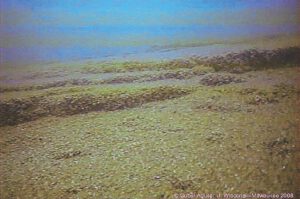 Russell Cuhel: Another important thing is the structure of a basin. When the basin structure—the bottom of a lake or river—is smooth, it is going to be a lot less rapidly colonized compared to a basin that contains heterogeneous structures. Rocks, pinnacles, or vertical structures can intercept currents that will allow the animals to not deplete their immediate areas of their food resources.
Russell Cuhel: Another important thing is the structure of a basin. When the basin structure—the bottom of a lake or river—is smooth, it is going to be a lot less rapidly colonized compared to a basin that contains heterogeneous structures. Rocks, pinnacles, or vertical structures can intercept currents that will allow the animals to not deplete their immediate areas of their food resources.
There is another related factor that has not yet been well established but has a lot of circumstantial evidence to support it. The productivity of a water body has at least two factors that are related to mussel success. One is whether there are enough plankton being produced. Plankton production may be seasonal, and if the mussels have a long period of low food availability, they need to survive until the next bloom. Then the question arises as to whether there is a lot of dissolved organic material in the water. That is something that may enable mussels to last through some dilute periods.
Joshua Dill: Would you tell our readers about the effects of the quagga mussels?
Russell Cuhel: Yes, but we need to distinguish between moving water and reservoirs or lakes, where the water is relatively still. Much less is known about the effects in
moving waters. In still waters, one of the first unequivocal effects is on water clarity. Water clarity and particle loading completely change; you get very clear, low-particle water. In Lake Michigan, transparency more than doubled; there is now enough light to see well without lights at depths of more than 200 feet. This makes for exceptional recreational or professional diving, as well as fishing for roaming top predators.
There is also an increased rate of deposition. The mussels suck in particles, and the ones that they do not use for making body tissue are returned to the water right where they are, but encased in a light mucus. These particles drop to the bottom, which becomes loaded with high organic-enriched material. That leads to localized anaerobic conditions where the bacteria break down the organic material, which leads to the depletion of oxygen at the water-sediment interface. The mussels may not be affected by the oxygen depletion because it is going on underneath them, and they can slowly move away. But it changes the mobilization of many elements, particularly metals, and in some deep pockets it can lead to localized anoxic conditions that can suffocate the mussels themselves. You can get pockets of anoxic muds where the bacteria will mobilize metals and stable mineral nutrients that can escape into overlying water.
Carmen Aguilar: For people who are treating water and relying on water movement, one of the main concerns is always the clogging of pipes and screens, which reduces pumping capability. What we have seen here with Wisconsin Energy is that they have to stop the flow and exchange screens to remove the mussels. When they are in pipe systems, the mussels tend to form multiple layers and have to be physically removed. We have been working with the water treatment facility here to let them know when there is a burst of veligers. That way they can do chemical treatments to protect their pipes. As Russell was saying, if you have a lot of mussels, the water may become depleted in calcium and experience other chemical changes. It is important for those in the industry to know when veligers are reproducing in their system.
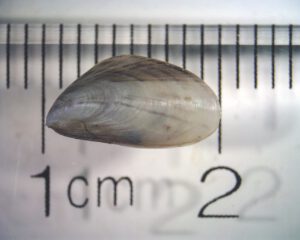 I got a call one time from California about irrigation, which the state relies on heavily. One thing I mentioned to them is that, even if an irrigation system stops its water for a period of time and lets things dry, not everything will dry completely. These organisms can survive for about 5 days with no water surrounding them. There is also the concern that these mussels could change the characteristics of the water being used for irrigation. Removing and treating these mussels will of course add costs to an operation: When you have to stop a system, or have to send divers out to remove the mussels, it is going to add to your bottom line.
I got a call one time from California about irrigation, which the state relies on heavily. One thing I mentioned to them is that, even if an irrigation system stops its water for a period of time and lets things dry, not everything will dry completely. These organisms can survive for about 5 days with no water surrounding them. There is also the concern that these mussels could change the characteristics of the water being used for irrigation. Removing and treating these mussels will of course add costs to an operation: When you have to stop a system, or have to send divers out to remove the mussels, it is going to add to your bottom line.
Joshua Dill: Would it be fair to say that sooner or later the quagga mussel is going to get into a majority of the water bodies in the western United States?
Russell Cuhel: Yes. I have a phrase—not many people like it, but it holds some truth: “It only takes one idiot.” If
you have one person who takes a small fishing boat with an outboard motor from a contaminated lake during the veliger period into any other place, and the veligers get out there, it is over. There is nothing that you can do in an ecologically or socioeconomically practical way to get rid of them once they are in. But you can assess where to best place your resources by careful analysis of the water chemistry and environmental conditions of your site. Low-calcium waters are of less concern, for example.
When we were working with the Metropolitan Water District, they told us that, in studying the movements and potential impacts of the quagga mussel, one of the things that would save the most effort would be to know where they did not have to worry about the mussels. They submitted a request to study the calcium requirements of veligers’ settling, and we wrote a proposal, but California went into financial trouble around that time and killed the study. The point was that lakes and rivers with low calcium are unlikely to have significant infestation. You can think about that in figuring out where to focus your efforts. It may not be an easy choice, but it needs to be made.
Carmen Aguilar: Educating the public is a big and necessary step. Mussels are in the surface water: Getting people to understand that is really important. We go a lot to fishing clubs and other places and we tell the people there that they are the ones who can protect against these mussels. There are a lot of people who like fishing in different systems and they do not think about how the mussel cycle works. As they go from one system to the next without taking care of the water in their motors, they transport the mussels. It may take a long time, but it will happen. The connectivity of the river systems in the West is going to be of concern for California.
Joshua Dill: It sounds like, other than prevention, there is no reliable way to remove quagga mussels from a water body once they are present.
Russell Cuhel: I would say that is correct. There are some lessons from the Great Lakes that can help people in the West. The first thing is that this is a great opportunity to use citizen science. For a small investment, you can equip local activist groups with underwater video cameras that can allow for the surveying of water bodies on a regular basis. There are plenty of citizen-science groups that would be willing to help.
The second thing is this. One of the big mistakes here in the Great Lakes was to assume that what was happening during the first few years of invasion was going to keep happening. The animals only live for 12–15 years. During the first years of establishment, they have a huge new effect on the ecosystem, but once they have been there for 10 years or more, they reach a new equilibrium at which the new ones are replacing the old. Because quagga mussels here live in a monolayer in still water, once they have established their habitat, the new ones will come in at the rate at which the old ones die off. There is a curve of impact that is very steep during the first 10 years; it levels off after that. Big lakes like Lake Mead that have had quagga mussels for about 10 years should be reaching stable conditions. That is why I think it is important for those in the West to do studies to establish where they are in the mussels’ community-development scheme.
For more about the University of Wisconsin–Milwaukee’s School of Freshwater Sciences, visit its website at https://uwm.edu/freshwater/. Drs. Cuhel and Aguilar can be reached by email at rcuhel@uwm.edu and aguilar@uwm.edu.

